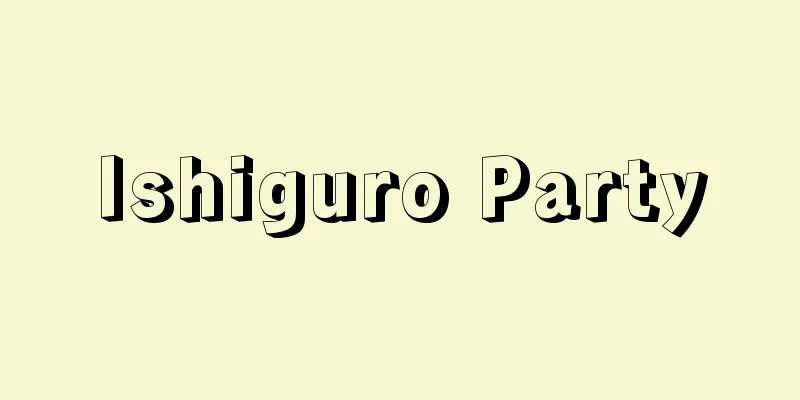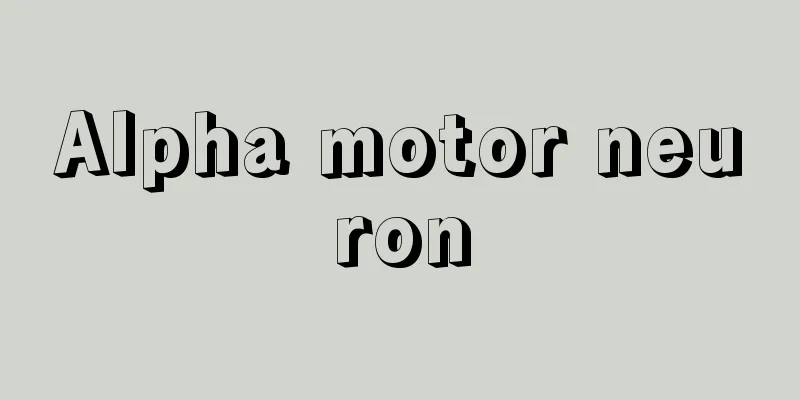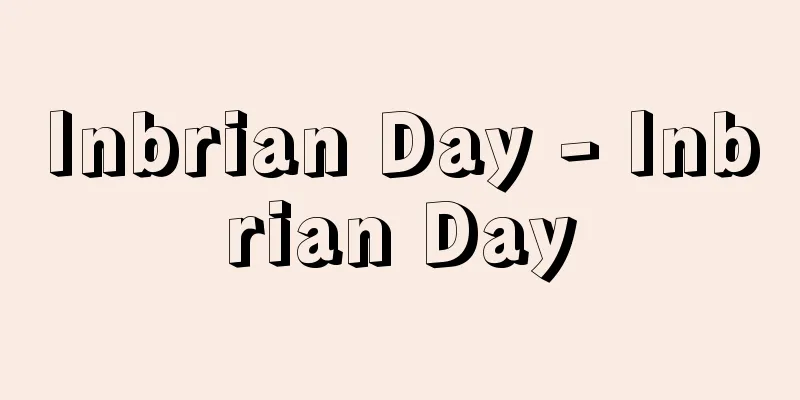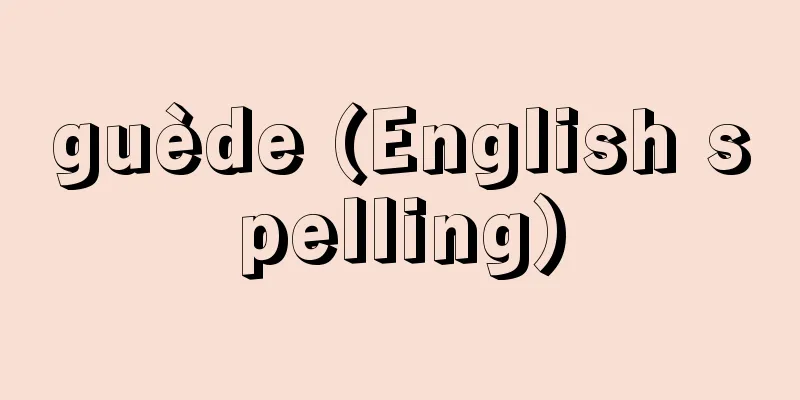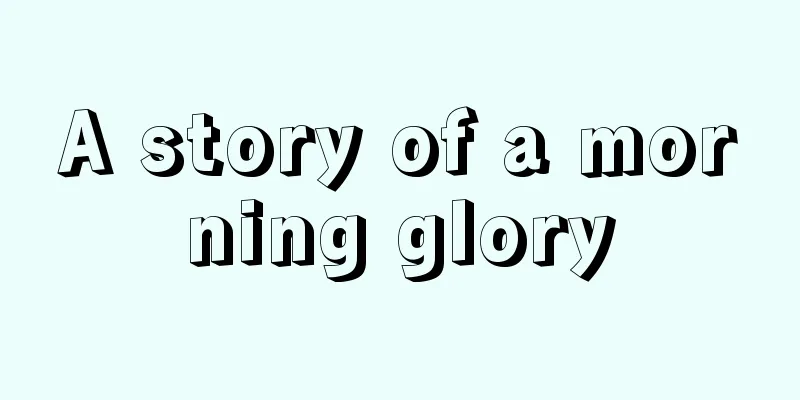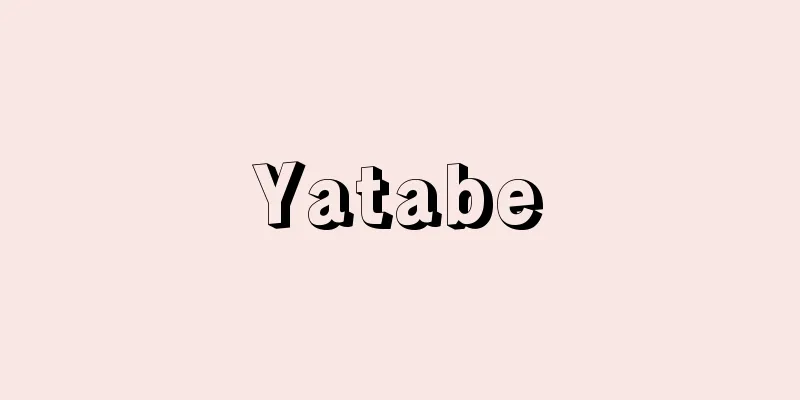Dyeing - Senshoku

|
It is the process of using dyes to penetrate and fix color into objects, which can be distinguished from the process of attaching pigments to the surface of objects using a medium. However, even among the processes known as dyeing, there are many that treat pigments or dyes as if they were pigments and paint, rub, or print them, and even though they are called dyeing and painting, the distinction between the two is sometimes unclear near the boundary between them. [Yamabe Tomoyuki] originIt is clear from the strong preference for color among primitive peoples today that humans have had a strong interest in color since ancient times. This is due to a strong unconscious creative urge to express external stimuli in their environment or what is inside them, and also to protect themselves from visible or invisible enemies. To this end, they decide on the colors of their tribes, family colors, and colors that have religious or curse meanings, and impose strict restrictions on the use of not only the colors themselves but also the materials they are made of. The first step in the quest for color would be to use natural products without any modification: leaves, flowers, feathers, fur, shells, stones, or anything else that has color. The next thing to be used were pigments, which were often made from powdered minerals, lime, or mud (yellow ochre and red clay). They were first used to color the body directly, and then people started using them to color clothing. These pigments are strong against light, but weak against water and moisture when worn, so adhesive media were devised, and eventually dyes began to be used, progressing from substantial dyes, which were dyed directly with dyes that dissolved in water, to vat dyes, and then to mordant dyes. Regarding the use of dyes, in addition to the aesthetic creativity and religious or magical symbolism of colors mentioned above, direct medicinal effects can also be considered. Furthermore, such ideas about dyeing have survived in us in some form from the very ancient barbarian times to the present day. Today, it goes without saying that we like beautiful colors and patterns, but there was also a custom of considering black as the color of mourning and red as a symbol of youth, of using navy blue hand guards and leggings to ward off vipers, and of dyeing newborn clothes with turmeric to keep fleas away. Dyeing can be broadly divided into plain dyeing and patterned dyeing. [Yamabe Tomoyuki] Plain dyedPlain dyeing is dyeing cloth or threads in one color, and in terms of dyeing technique, this simply means dyeing evenly, but rather, the issue is how to produce the color. In particular, with natural dyes, where the dyes cannot be mixed in advance to produce the desired color like chemical dyes, when mixing two or more colors, for example indigo and yellow, to produce green, it is necessary to base dye once and then overlay the other colors on top, and even with one color, the difference in the shade of the color occurs depending on the number of times it is immersed in the dye, that is, the number of baths, so it is difficult to match the colors. When using natural dyes to produce the desired concentration, in Japan, to obtain deep colors such as purple, madder, crimson, and indigo, several dozen baths were used. Especially in times and places where dyeing technology was not yet advanced, it took an unimaginable amount of time to do this. It is said that it took five years to produce a deep brown color in Tenganan, Bali, and as much as ten years in East Flores. It is said that even indigo dyeing of cotton cloth by the Batak people of North Sumatra took one to two years. In this way, by repeatedly dyeing light colors, the warmth and depth of the colors that are unique to natural dyes were born, and it goes without saying that one of the good points of natural dye colors is not just the use of them, but the way they are handled. [Yamabe Tomoyuki] Pattern dyeingIn contrast to the plain dyeing described above, pattern dyeing involves using dyes to create patterns on the fabric. This can be done by painting the fabric directly onto it, or by immersing it in dye to create a pattern. Draw pictures are the simplest type of pattern dyeing, and are the same as painting pictures on the surface of fabric. Some simple ones are simply colored with pigments or plant juices, in the same way as coloring the human body. Advanced techniques using pigments or dyes treated like pigments include pre-Inca draw pictures and draw pictures found on textiles in the Shosoin Repository. Indian draw pictures are a more advanced form, and in some cases, dip dyeing with resist dyeing is used. Draw pictures using ink and vermilion can also be found in Japanese Tsujigahana dyeing, and are sometimes used as part of Yuzen dyeing. Famous artists also draw patterns on kimonos and obi with ink painting, and mame-gaki Yuzen, in which soybean juice is rubbed into the ink, is also part of this. Other techniques that apply color directly to the surface of fabric include print dyeing, katazuri, surie, and suminagashi. On the other hand, when creating a pattern by dip dyeing, whether it is a single color or multiple colors, a resist dye must be applied to a part of the fabric surface to prevent the dye from penetrating. Depending on the type of resist dyeing method used, various pattern dyeing methods are divided. [Yamabe Tomoyuki] Pressure ResistantThis method involves covering part of the fabric surface and pressing it down by means of tying or clamping to prevent the dye from being dyed, and the most common type is shibori. Shibori has the longest history as a pattern dyeing technique and has been practiced in various parts of the world. It can be said that it is distributed all over the world except Oceania. In particular, shibori from India and Indonesia in the East is famous, and today the academic terms plangi (Malay), tritik (Java), and bandhana (Indian) are from each region. Indian shibori is often made of cotton or silk with multicolored floral patterns and Indian pine (paisley) patterns created by fine pinch shibori and sewing. In Indonesia, the materials and techniques differ depending on the island, but in Sumatra and Bali, silk shibori is known as slendang (drapes) with a large plain shibori in the center and a sewn shibori pattern on the periphery, and cotton shibori in Java and Celebes. In Africa, there are many woolen and cotton shibori that show a simple, folk-like strength. In the Americas, shibori can also be found in Mexico, Guatemala, and Argentina, but the ancient Peruvian shibori from the pre-Inca period is unique in that it is made by packing elastic cotton woven with tightly twisted yarn like a stone wall and shibori. Japanese shibori is probably a technique that was learned from ancient China, but while Chinese shibori is now mainly a folk tradition in southern China, and while it is often large and simple, such as the shibori of felt commonly known as Mongolian kimono, it has developed into a very diverse style. The elaborate shibori of Tsujigahana dyeing, which appeared in the middle of the Muromachi period from the ancient dyeing method of Kokkechi through the Heian and Kamakura periods, further evolved into the so-called Kyohitta style of intricate shibori in the Edo period. On the other hand, even in the common cotton dyeing practiced in Narumi and Arimatsu (Nagoya), dozens of different techniques are used, even just the basic ones, such as Miura, Kumo, Makiage, Rasen, and Kokuri-shibori for hats, and Yoro, Mokume, and Shirakage sewing techniques. Kyokechi, which was introduced to Japan from China long ago, is a technique similar to itajimezome, in which cloth is dyed by sandwiching it between boards or pieces of wood. The details of the technique for multi-colored itajimezome are currently unknown, but it is thought that it may be related to a technique used in China until later times, in which a piece of cloth is sandwiched between two wooden molds with openwork patterns and dyed with multi-colored dyes. Japanese itajimezome later developed into a technique in which cloth is sandwiched between many boards in a zigzag pattern and fastened, but this technique ended during the Taisho period. Currently, the only technique used in the Arimatsu region is sekkashibori, in which cloth is folded finely and two pieces of wood are placed on both sides to fasten it, and then dyed. Shibori is originally a method of dyeing patterns using the dye color and the natural color of the fabric, but when it is done in multiple colors, the tie-dye is partially undone for each color and several colors are dyed. Conversely, tie-dyeing can also be added to parts dyed with one liquid. However, if there are too many colors, the colors of the overlapping parts become muddy, so the limit is about three colors, and if there are more than that, parts are partially pinched-dyed, or a large part that has already been dyed is covered and dyed. Sometimes coloring is added instead of dip dyeing, but if it becomes too technical, the original appeal of shibori can be lost. [Yamabe Tomoyuki] Resistance to dyeing by adhesion of resistThis is the most technically diverse resist dyeing method, in which a substance such as wax, paste, mud, or rubber that prevents the dye from penetrating the fabric is applied to create a pattern. Depending on how the resist dyeing is applied, it can be divided into hand-drawn and stencil-dyed. (1) Wax resist dyeing This is the so-called wax-resistant dyeing, and batik is a word from Java, which is said to be the birthplace of this technique. Batik is practiced in Indonesia, including Java, southern Sumatra, and Celebes, as well as India, Hainan Island, southern China, the Bohra region of the Middle East, and western Africa. Patterns are drawn on the surface of the fabric using heated and melted wax. In Java, wax is poured into a pipe-like tool with a thin nozzle called a tjanting, which is tilted to draw lines, and in India, human hair or aloe fibers are wrapped around a thin iron comb, which is then dipped in wax to draw. In Java, a copperplate printing method called tjap was used from the mid-19th century, and many cheap mass-produced works came to be made using this method. Japanese wax dyeing was introduced from China during the Nara period, and can be seen today on dyed textiles in the Shosoin Repository, but the wax is not hand-painted, but is stamped using a mold (probably made of wood). This technique then fell into disuse, but was revived in the Meiji period for Javanese chintz and has continued to be used to this day. (2) Paste-resist dyeing This method uses rice paste as the main ingredient to create patterns and resist dyeing, but it is not as common as wax-resist dyeing worldwide. It was practiced in parts of Java from ancient times, and indigo dyeing using woodblocks to apply paste (wheat paste in this case) to cotton and linen fabrics remained in the folklore of various regions, for example in Switzerland and Czechoslovakia in Europe, but is rarely seen today. Paste resist dyeing was highly developed in Japan (including Okinawa), where it began to be practiced from around the end of the Middle Ages. At first, komon dyeing was done by applying paste with a spatula to patterns carved into stencils, but from the early to early middle Edo period, yuzen dyeing was started, in which patterns were drawn by hand with thin lines of paste, and then colored by applying dyes and pigments, and Japan's unique paste resist dyeing was perfected. Bingata dyeing of Ryukyu is a combination of komon-style stencil dyeing and yuzen-style painted dyeing, and has a unique beauty with its gorgeous coloring as a stencil-based picture pattern. Serizawa Keisuke's stencil-e dyeing, designated as an Important Intangible Cultural Property, further developed the bingata technique into Japanese-style picture pattern dyeing. In addition to this, there is also chugata stencil dyeing, which has a slightly larger pattern than komon. This is indigo-dyed cotton fabric used for yukata (summer kimonos) worn by common people during the Edo period, worn as a single layer in the summer, with starch applied from both sides. Chaya-zome, used by women of the samurai class for summer clothing for common people, was made by hand-dying high-quality choma cloth with intricate patterns applied with starch and then indigo-dyed, and is said to be the most time-consuming and labor-intensive method of starch-resistant dyeing. From the mid-Meiji period onwards, chemical dyes have been used exclusively for Yuzen dyeing, komon dyeing and chukata dyeing, and recently raw rubber has also been used for Yuzen paste. On the other hand, traditional natural dyes are still used in some areas and are enjoyed by a limited number of people. As for print dyeing, as mentioned in the section on painted picture dyeing, there are painted chintz and printed chintz in India, and the two are used together (for example, by printing the lines of a pattern and then adding hand coloring), and some also incorporate wax resist dyeing. The print is made by using relief wooden molds in parts to create the pattern. Most of the chintz made in Iran today is this block chintz. Chintz entered Europe further in the 18th century, and fairly elaborate printed chintz was made in France and the Netherlands using copperplate printing. Many of the items imported to Japan by Nanban ships in the late Edo period were of this type. In Japan, printing using wooden stencils is a type of technique used in surie paintings from the Nara period, and was later used in surimono prints of ban-e paintings, but in modern times, dyes are applied directly to the surface of the fabric using stencils. However, this technique has been used most effectively since the Meiji period in kata-yuzen, which uses paste paste. Instead of using paste, this method uses numerous stencils to apply the dye directly to the fabric, one color at a time. Finally, there is the print dyeing method of the suminagashi type, which is neither plain dyeing, nor drawing dyeing, nor stencil dyeing, in which the pattern created by the dye itself is transferred to the fabric. In foreign countries, there is marble printing, which is a method of dyeing paper using this method. Turkish marble printing is famous, and even today, very elaborate pieces are made using this method. In Japan, it was used for dyed paper in the past, but from the end of the early modern period it has been applied to cloth, and similar items are made using dyes mixed with glue. [Yamabe Tomoyuki] Modern dyeingDyeing is a processing method for coloring textiles, paper, leather, plastics, and other similar items, but unlike simple coloring, it uses a coloring agent (dye) that absorbs directly from the solution onto the object to be dyed (subject) and gradually reduces the dye concentration in the solution, so that the dye does not easily wash away from the dyed object due to washing, sweat, water, etc., and it is a coloring that shows considerable resistance (color fastness) to various effects during use. However, mordant dyes or pigment resin colors that can absorb with the aid of a medium (mordant) or fixing agent are also used, even if they have almost no dye absorption. Many of the vegetable dyes that have been used since ancient times belong to the mordant dye category. Dyeing is an important process that not only enhances the decorative value of a product, but also determines its quality. Since color durability is an important quality factor, particularly in dyed products intended for consumption, it is necessary to use dyes that are suited to the type, properties and use of the fabric to be dyed. [Koshikawa Toshikazu] Dyed materials and dyes(1) For cotton, linen, rayon and other cellulose fibers, reactive dyes, direct dyes, vat dyes, sulfur dyes, naphthol dyes, etc. are mainly used. Reactive dyes are dyes that bind to cellulose through covalent bonds, and alkali is used in the dye liquor to promote the reaction. They are often used in recent years because they have vivid colors, high color fastness to washing and hot water, etc., and can be dyed at relatively low temperatures (below about 80°C). Direct dyes, vat dyes, sulfur dyes, naphthol dyes, etc. bind to cellulose mainly through hydrogen bonds. Neutral salts such as sodium sulfate and sodium chloride promote dyeing, so these neutral salts are added to the dye liquor when dyeing dark colors. In addition, nonionic and anionic surfactants reduce dyeing, so they are often added to the dye liquor for the purpose of leveling and slowing the dyeing. Direct dyes are water-soluble, but vat dyes and sulfur dyes are water-insoluble. Sodium hydroxide and hydrosulfite are added to the former, and sodium sulfide is added to the latter, turning them into reduced forms (leuco compounds) and dissolving them in water. After dyeing, the dye is oxidized by air oxidation or other methods to restore the original dye to the fabric. In the past, lime, wood ash, and shell ash were used as alkaline agents for natural indigo, a typical vat dye, and starch syrup, bran, starch, and zinc powder were used as reducing agents. Naphthol dyes consist of two components, a priming agent and a developer, which are treated separately to generate the dye within the fabric. Since naphthol AS, which is used as a priming agent, is insoluble in water, sodium hydroxide is added to make an aqueous solution that is absorbed into the fabric. There are two types of developers: bases and salts. Salts are convenient to use because they dissolve in water as they are and react with the priming agent to generate pigments. The reaction between the priming agent and the developer is achieved quickly at room temperature, so both priming and development can be achieved with a short period of time at room temperature. Pigment resin colors are also used for dyeing cellulose fibers. These dyes are fixed to the substrate by a synthetic resin fixing agent, and are primarily suitable for textile printing. By selecting the appropriate fixing agent, they can be applied to various types of fibers. (2) Acid dyes and acid mordant dyes are primarily used for wool, silk, and other protein fibers, as well as nylon. These dyes are absorbed primarily through ionic bonds with protein fibers and nylon. As the pH of the dye liquor decreases, absorption is promoted, and absorption is inhibited by anionic, nonionic, or amphoteric surfactants, so these are often added to the dye liquor as leveling agents. Acid mordant dyes are treated with mordants such as dichromate and chrome alum before or after dyeing, turning the dye into a metal complex compound and then absorbing. Reactive dyes are also used for these fibers, and logwood and other vegetable dyes and mordant dyes are used for silk. Leather exhibits similar dyeability as protein fibers, so the same types of dyes are used, but oxidation dyes are also used for fur, upper leather, etc. (3) Synthetic fibers and acetate fibers are poorly hydrophilic, and dyes suitable for cellulose fibers and protein fibers are difficult to dye, so disperse dyes are usually used. Disperse dyes are poorly soluble in water, so dispersants are added to make them into aqueous dispersions. These fibers are mainly dyed by hydrogen bonds. Polyester fibers have a dense fiber structure, making it difficult for dyes to diffuse into the fibers, so they are dyed at high temperatures of over 100°C, thermosol dyeing, or carrier dyeing using methylnaphthalene, phenol derivatives, chlorobenzenes, etc. as dyeing promoters. Vinylon has different dyeability between the outer layer (skin layer) and the inner layer (core layer). The skin layer is dyed with disperse dyes like general synthetic fibers, but the core layer has dyeability similar to cellulose, so these two types of dyes are used together, or, especially for fast, deep color dyeing, a naphthol dye priming agent and developer (base) are used in the same bath, followed by diazotization and development, using the azoic dyeing method. Acrylic and acrylic fibers have a high affinity with cationic dyes and can be dyed in vivid colors, so they are usually dyed with cationic dyes. Polyolefin fibers, polyvinyl chloride fibers, and vinylidene fibers are extremely difficult to dye, so dope dyeing (undiluted coloring) is used for dark colors, but disperse dyes, oil-soluble pigments, or some mordant dyes are used for light colors. Generally, a carrier is used in combination. In recent years, transfer printing using sublimable organic pigments has come to be applied to synthetic fibers, especially acetate, for pattern dyeing, and these fibers, which were previously difficult to dye using conventional methods, can now be dyed relatively easily. [Koshikawa Toshikazu] Dyeing methodDyeing is done in a variety of ways depending on the shape and type of the object to be dyed, the dyeing effect, and so on. These include dip dyeing, where the object is immersed in the dye solution, pad dyeing or pull dyeing, where the dye solution is applied, spray dyeing, printing by printing, or transfer printing, where a sublimation dye is heated and transferred, and many other methods. Dip dyeing and pad dyeing are mainly used for solid dyeing, and printing is mainly used for pattern dyeing. In addition, handicraft methods such as drawing dyeing, tie dyeing (such as tie dyeing and kasuri thread dyeing), wax dyeing, and other methods are also used. In dip dyeing, the item to be dyed is immersed in a dye solution prepared by adding dyeing auxiliaries such as accelerants to promote dyeing, leveling agents to make the dyeing even, or fiber protectors, and then heated to an appropriate temperature to dye it. Depending on the type of item to be dyed, there are various types of dyeing, such as loose wool dyeing, top dyeing, cake dyeing, cheese dyeing, skein dyeing, warp dyeing (vertical threads), cloth dyeing, and sewn product dyeing, and each type is dyed using a dyeing machine suitable for that purpose. For dyeing loose wool or sash-like materials, a package dyeing machine is used in which the material is filled into a porous cylinder and dyed; for dyeing filamentary materials, a beam dyeing machine, a cheese dyeing machine, or a cake dyeing machine are used in which the material is wrapped around a porous tube and the dye liquor is circulated through the layer of filaments; for dyeing skeins, a rotating bag or a jet-type skein dyeing machine is used in which the material is hung in a hanging rod or porous tube while still in a skein and the dye liquor is circulated; for dyeing cloth, a jigger, a pad dyeing machine, or a continuous dyeing device in which the material is circulated in the dye liquor in a spread-out state, a winch dyeing machine in which the material is circulated in a rope-like state, a liquid flow dyeing machine, or a jet dyeing machine in which the material is circulated by the flow of the dye liquor, are used for dyeing thin synthetic fiber fabrics and warp knitted fabrics. Beam dyeing machines are also used for thin synthetic fiber woven fabrics and warp knitted fabrics. For secondary products, semi-finished products, knitted fabrics, etc., paddle dyeing machines, in which the dyed item flows gently due to the flow of the dye liquor, and rotary (rotating drum type) dyeing machines, in which the item to be dyed is placed in a perforated cylinder and rotated to dye it, are used. In recent years, there has been remarkable development and improvement of new technologies aimed at automating work, utilizing waste heat and waste liquid, lowering dyeing temperatures, shortening dyeing times, increasing dyeing concentration, and dyeing difficult-to-dye fibers. Methods such as automated color matching, small bath ratio dyeing, foam dyeing, solvent dyeing, and solvent addition dyeing have been developed and are being implemented in some areas. In textile printing, starch, rubber paste, seaweed paste, carboxymethyl cellulose, or other pastes are added to the dye solution to prevent the dye from seeping out of the printed area, and the pattern is printed and then dyed by steaming or other methods (direct textile printing method); the pattern is first dyed (ground dyeing) and then bleached or dyed a different color at the same time (discharge printing method, the former is called white discharge printing, the latter color discharge printing); or the pattern is dyed by printing a white or colored paste to prevent dyeing and then printing a colored paste (direct textile printing paste) (the former is called white resist printing, the latter color resist printing). Tie-dyeing, board-tied kasuri dyeing and other tie-dyeing methods, as well as stencil dyeing, are not textile printing methods but are resist dyeing methods. Textile printing is primarily done on fabric, but can also be done on thread, as in the case of ikat dyeing. Methods for printing printing paste include roller printing, which uses an engraved roller, screen printing, which uses a screen mold made of gauze or thin metal sheet and is used as a cut-out mold (a method that uses a cylindrical metal screen is called a rotary screen), and stencil printing, which uses a stencil with a pattern carved into astringent paper. A special method that has been used in recent years is transfer printing, in which transfer paper printed with a sublimation pigment is placed on the item to be dyed and then heated and transferred to dye the pattern. In recent years, with the trend toward small-volume, high-mix production, easy-to-work-with flat screen and rotary screen printing have become mainstream, and roller printing has declined significantly. [Koshikawa Toshikazu] Preparation for stainingBefore dyeing, the fabric must be cleaned by removing dirt, impurities, and processing agents, in order to improve the penetration of the dye, uniform dyeing, color clarity, and color fastness. For this reason, desizing, scouring, and washing are performed. In addition, bleaching is also performed for fabrics that are dyed in light or vivid colors. For desizing, starch-decomposing enzymes, proteolytic enzymes, or alkaline agents are used depending on the type of paste attached, but sodium bromite or other oxidizing agents are used for synthetic pastes such as polyvinyl alcohol. Scouring is performed with a hot liquid containing soap, synthetic detergent, sodium carbonate, and other alkaline agents. For bleaching, oxidizing bleaching agents such as hydrogen peroxide, sodium chlorite, and sodium hypochlorite, or reducing bleaching agents such as hydrosulfite are used. Furthermore, in the case of printing woolen fabrics, pretreatment is often performed to improve the penetration of the printing paste and enhance the printing effect, such as chlorination with hypochlorite or treatment with a moisture absorbent, as well as singeing. [Koshikawa Toshikazu] "Dyeing - Theory and Techniques" by Toraichi Nishida (1983, Kasei Educational Publishing) " "New Edition of Outline of Dyeing" by Akihiko Yabe and Masako Hayashi (1979, Koseikan) " "Dictionary of Dyeing" edited by the 120th Committee on Dyeing and Processing of the Japan Society for the Promotion of Science (1982, Asakura Publishing) [Reference items] | |Source: Shogakukan Encyclopedia Nipponica About Encyclopedia Nipponica Information | Legend |
|
染料を用いて物に色素を浸透、定着させることで、これは顔料を媒剤(ミディアム)によって物の表面に付着させることといちおう区別して考えられる。しかし、染色といわれているもののなかにも顔料やまたは染料を顔料のように扱って塗ったり摺(す)ったりプリントしたものは多く、染め・塗りといっても、その境界点の近くでは両者の区別は判然としないところもある。 [山辺知行] 起源人類が非常に古い時代から色に関して強い関心をもっていたことは、今日、未開民族の間における色彩への強い嗜好(しこう)性をみれば明らかなことであろう。これは、彼らの環境における外界の刺激または彼らの内にあるものを外へ表そうという無意識的な強い創造への衝動と、また一方では可視的あるいは不可視的な敵に対して自己を守ろうという目的をもっている。このためには彼らは、各自の部族の色、家族の色、さらに信仰的ないし呪(のろ)い的な意味をもつ色を決め、色彩それ自身はもちろんのこと、その材料にまで厳しい使用上の制約を設ける。 色を求めて最初に扱われるのは、自然の産物をなんらの加工も加えずに用いることであろう。木の葉、花、羽毛、獣毛皮、貝、石など、なんでも色のあるものを身につける。 次に用いられるのが顔料(ピグメント)で、これは多く鉱物、石灰、泥(黄土(おうど)・丹土(につち))が粉末にして用いられた。まず肉体を直接それらで彩ることが行われ、やがて、これで衣料に色をつけたりすることが始まると、光線には強いが、着用するうえには水や湿気などに弱いこれらの顔料に対して、接着用の媒剤が考えられ、やがて染料の使用が始まり、まず水に溶解する染料を直接的に染め付ける直接染料substantive dyesから発酵染料(建染め染料)vat dyes、そして媒染染料mordant dyesにまで進展していく。 染料の使用に関しては、前に述べた美的な創造性、信仰的ないし呪術(じゅじゅつ)的な色のもつ象徴性のほかに、直接薬物的な効果ということも考えられる。また、こういう染め色に関する考え方は、非常に古い未開の時代から今日までなんらかの形でわれわれのなかに生きている。今日、われわれが美しい色や模様を好むことはいうまでもないが、黒を喪の色とし、赤い色を若さの象徴と考え、紺染めの手甲(てっこう)や脚絆(きゃはん)がマムシよけになるとか、幼児の産着をノミのつかないためにと欝金(うこん)染めにするとかいう習慣もあった。大別して無地染めと模様染めとする。 [山辺知行] 無地染め無地染めは布または糸を一色に染めることで、これは染色の技術としてはむらなく染めるというだけのことで、それよりも、まず、いかに色を出すかということが問題である。とくに化学染料のように染料をあらかじめ調合して所望の色を出すことのできない天然染料では、たとえば藍(あい)と黄という二つ以上の色をあわせて緑をつくる場合には、一度下染めをして、その上に他の色をさらに上(うわ)がけしなければならないし、一つの色でも染料に浸す回数、すなわち浴数によって色の濃淡の差が出てくるので、色をあわせることはむずかしい。天然染料を用いるとき、所望の濃度をつくる場合、日本でも紫や茜(あかね)、紅(べに)、藍などの濃色を得るためには、十数回から数十回の浴染が行われた。ことに染色技術の進んでいない時代や場所では想像に絶するほどの時間がこれに費やされた。バリ島のテンガナンでは濃褐色に仕上げるのに5年かかったといい、東フロレスでは10年もかかったという。北スマトラのバタック人の木綿(もめん)布は藍染めでさえ1年から2年を要したといわれる。このようにして薄色を何度も重ねて染めたところに暖かみと厚みのある天然染料独特の色合いが生まれたのであって、天然染料の色のよさの一つが、ただそれを用いたというだけでなく、これをいかに扱うかという点に大きな原因があるのはいうまでもないことである。 [山辺知行] 模様染め以上の無地染めに対して、模様染めは染料を用いて布の上に模様を染め表していくので、これには生地(きじ)の上へ直接色を塗っていく描(か)き絵と、これを染料に浸して模様を表す場合とがある。 描き絵というのはもっとも簡単な模様染めで、布面に絵を描くのと同じで、素朴なものには顔料や植物の汁などで、人体を彩るのと同様に布面を彩色したにすぎないものもある。これが進んで顔料もしくは顔料的に扱われた染料を用いたものに、たとえばプレ・インカの描き絵染めや、正倉院の染織品にみられる描き絵などがある。インドの描き更紗(さらさ)などはこれがさらに進んだ形で、一部に防染による浸染の用いられている場合もある。日本の辻(つじ)が花染めにも、墨や朱などによる描き絵がみられるし、友禅染めの一部にも行われることがある。また、著名な画家が着物や帯に墨絵で模様を描いたり、また、墨のなかへ豆汁(ごじる)を摺り込んだ豆描き友禅といったものもこの一部であろう。また布面へ直接色をつけるものにプリント染めや型摺り、摺絵(すりえ)、墨流しなどもある。 これに対して浸染によって模様を表す場合は、それが単色の場合も多色の場合も、布面の一部に染料の浸透を抑制する防染が施されなければならない。ここに、どのような防染法を用いるかということで、種々の模様染めの方法が分かれてくる。 [山辺知行] 圧力による防染布面の一部を覆い、縛る、挟むなどの方法で押さえて防染するもので、もっとも一般的なものに絞りがある。 絞りは模様染めの技術としてもっとも古い歴史をもっており、世界の各地方で行われてきた。それは極言すると、オセアニアを除いて世界の各地に分布しているといってよい。とくに東洋のインド、インドネシアの絞りは著名で、今日一般に学術用語として用いられているプランギplangi(マライ語)やトリティックtritik(ジャワ)、バンダナbandhana(インド)はそれぞれの地方のものである。インドの絞りは木綿または絹に精細なつまみ絞りと縫い締めによる多色な花模様やインディアン・パイン(ペイズリー)などの模様を表したものが多い。インドネシアは各島々によって材料も技法も異なるが、スマトラ、バリ島の絹絞りでは、中央を大きく無地に絞って周縁部に縫い絞りの模様を配したスレンダン(掛け布)、ジャワ、セレベスの木綿絞りなどが知られている。アフリカにも毛織物や木綿の絞りに民俗的な素朴な力強さをみせたものが多い。アメリカ大陸では、メキシコ、グアテマラ、アルゼンチンなどにもあるが、古くプレ・インカ時代のペルーの絞りは、強撚糸(きょうねんし)で織った弾力のある木綿を石垣(いしがき)のように詰めて絞ったもので、他に類例のない珍しいものである。日本の絞りは、おそらく古く中国からその技術を学んだものであろうが、中国の絞りが現在では主として華南方面の民俗的なものになっているほか、俗に蒙古氈(もうこせん)といわれるフェルトの絞りなどにみるような大柄な単純なものが多いのに対して、非常に多様なものに発展している。上代染色の纐纈(こうけち)から平安・鎌倉時代を経て室町時代のなかばごろから現れた辻が花染めの精巧な絞りは、さらに江戸時代に入ると、いわゆる京匹田(ひった)系統の精細なものとなった。一方、鳴海(なるみ)、有松(ありまつ)(名古屋)に行われた庶民的な木綿絞りにも三浦・くも・巻き上げ・羅仙(らせん)・帽子などのくくり絞り、養老・杢目(もくめ)・白影(しらかげ)などの縫い締めなど、基本的なものだけでも数十種にわたる技法が行われている。 板や木片を用いてその間に布を挟んで染める板締め染めと同じものには、古く中国から日本に伝来したきょう纈(きょうけち)がある。多色な板締め染めとして、その技術の細部は現在不明であるが、中国で後世まで行われた技法に、文様を透彫りした2枚の木型の間へ裂(きれ)を挟んで、多色の染料を通して染める方法があり、あるいはこれと関連があるのではないかと考えられる。日本の板締め染めは、その後、板を多く用いてその間へ裂地をジグザグに挟み締めて染める技術が発達したが、これは大正時代で終わっている。現在は有松地方で雪花(せっか)絞りといわれる、裂を細かく折り畳んで両側から2枚の木片を当てて締めて染めることが行われているだけである。 絞りは元来染め色と生地のもつ自然色で模様が染め出されるものであるが、これが多色で行われる場合、1色ごとに絞りのくくりを一部解いて数色を染めることが行われる。逆に1液染めた部分に絞りを加えていくこともある。ただし、あまり色数が多くなると重なった部分の色が濁ってくるので、3色ぐらいを限度とし、それ以上の場合は部分的に抓(つま)み染めするか、または一度染めた部分を大きく覆いくくって染めることが行われる。浸染のかわりに彩色を加えることもあるが、あまり技巧的になりすぎるとかえって絞りの本来の味が失われることもある。 [山辺知行] 防染剤の付着による防染防染法としてもっとも広い技術の幅をもつもので、生地の上へ蝋(ろう)、糊(のり)、泥土、ゴムなどの染料の浸透を防ぐ物質を接着して、これによって模様を表すもので、この防染の施し方によって手描きと型染めに分かれる。(1)蝋防染 いわゆる﨟纈(ろうけち)で、バティックbatikというのはこの技術の本場ともいわれるジャワのことばである。バティックの行われている地方は、インドネシアではジャワのほか南部スマトラ、セレベスなどで、インド、海南島、華南、中近東のボハラ地方、アフリカの西部などでも行われている。熱を加えて溶解した蝋を用いて布面に模様を描くのに、ジャワではチャンチンtjantingという細い口のついたパイプ状の器具へ蝋を入れてこれを傾けて線を描き、インドでは細い鉄の串(くし)のようなものへ人毛やアロエの繊維を巻き付けたものへ蝋を浸(し)ませて描く。ジャワでは19世紀の中ごろからチャップtjapという銅版を用いたプリントの方法が行われ、安い大量ものは、多くこれによってなされるようになった。 日本の蝋染めは、奈良時代に中国から伝えられたもので、今日正倉院の染織品にこれをみることができるが、蝋は手描きでなく、型(おそらくは木製)を用いてスタンプ式に押捺(おうなつ)されている。その後この技術はいつしか行われなくなり、明治時代に入ってふたたびジャワの更紗などによって技術が復活して今日に至っている。 (2)糊防染 米の糊を主剤としてこれによって模様を描いて防染するもので、世界的にみると、蝋ほど行われていない。ジャワの一部で古く行われたほか、各地の民俗のなかに、たとえばヨーロッパではスイス、チェコスロバキアなどに木版を用いて綿布、麻布などに糊(ここでは小麦糊)を置いた藍染めが残っていたが、今日はほとんどみられない。 糊防染が極度に発達したのは日本(沖縄を含む)で、だいたい中世末ごろから盛んに行われ始め、最初は型紙に模様を彫り抜いたものを用いて篦(へら)で糊を置いた小紋染めが行われていたのが、江戸時代の前期から中期初頭にかけ、細い糊の線を手描きにして模様を描き、これに染料や顔料を塗って彩色を加えていく友禅染めが始まって日本独特の糊防染の染色が完成された。琉球(りゅうきゅう)の紅型(びんがた)染めは、小紋系の型染めと友禅染めの塗り染めとが一つになったようなもので、型による絵模様としてその華麗な彩色とともに独特の美しさをもっている。重要無形文化財に指定された芹沢銈介(せりざわけいすけ)の型絵染めは、その紅型の技術をさらに日本的な絵模様染めに発展させたものである。型染めでは、このほかに小紋よりやや模様の大柄な中形(ちゅうがた)がある。これは江戸時代に庶民の浴衣(ゆかた)に用いられた木綿布に藍染めしたものだが、夏に単衣(ひとえ)で着るもので、表裏から糊を置いて染めてある。庶民の夏衣に対して武家の女性の用いた茶屋染めは、上質のチョマ布に手描きで精細な模様を糊置きして藍染めしたもので、糊防染の染色のなかでも、もっとも時間と労力のかかったものであろうといわれる。 友禅染めも小紋染めも中形染めも、明治中期以後は、もっぱら化学染料が用いられ、友禅の糊も最近は生ゴムを用いることも行われている。しかし、その反面、伝統的な天然染料を用いたものも一部ではあるが行われており、限られた人たちの間で愛好されている。 プリント染めについては、描き絵染めのところで触れたように、インドにおける更紗に、描き更紗とプリント更紗があり、この両者が併用され(模様の線をプリントして手彩色を加えるというように)、さらにこれに蝋の防染を加えたものもある。プリントは、凸版の木型により、これを部分的に用いて模様が構成されていく。現在イランで行われているものは、その大半がこのブロック更紗である。更紗はさらに18世紀ごろヨーロッパに入ってフランス、オランダあたりで銅版を用いたかなり精巧なプリント更紗がつくられている。江戸後期に南蛮船によって日本に輸入されたものにはこの種のものが多い。 日本で行われた木型を用いたプリントは、奈良時代の摺絵の技術の系統で、のちに蛮絵の摺り紋などに残っていったが、近世のものは型紙を用いて布面に直接染料を施すことが行われている。しかし、これがもっとも効果的に用いられるようになったのは、明治以後のうつし糊による型友禅である。これは、糊を用いるかわりに1色ずつ数多くの型紙を用いて染料を直接布地へつけていく方法である。 最後に、無地染めでもなく、描き染めにも入らず、型染めでもないものに、染料自体のつくる模様を生地に移していく墨流し系統のプリント染めがある。外国のものではこれを紙に染め付けたマーブル・プリントmarble printingがある。トルコのものは有名で、現在でも非常に精巧なものがつくられている。日本でも古くは染め紙に用いられたが、近世末期から布に応用されており、糊を交えた染料などによって同様のものをつくっている。 [山辺知行] 現代の染色染色は、繊維のほか、紙、皮革、プラスチックその他の類似品を着色する加工方法の一つであるが、単なる着色と異なり、染色対象物(被染物)に対し、その溶液から直接に染着し、しだいに溶液中の染料濃度を減少する性質の着色剤すなわち染料を用い、このため洗濯、汗、水などによって染色物から染料が容易に流れ去ることがなく、使用上の諸種の作用に対してもかなりの抵抗性(染色堅牢(けんろう)度)を示す着色をいう。しかし染着性がほとんどなくても媒介剤(媒染剤)または固着剤によって染着できる媒染染料またはピグメントレジンカラーなども使用される。古くから用いられてきた植物染料は、その多くが媒染染料に属する。 染色は、製品の装飾的価値を高めるとともに、品質を決定づける重要な加工であり、とくに消費材としての染色品においては、色の耐久性も重要な品質要因であるので、被染物の種類、性質、用途などにより、それに適合する染料を用いることが必要である。 [越川壽一] 被染物と染料(1)綿、麻、レーヨンその他のセルロース繊維には主として反応染料、直接染料、バット染料、硫化染料、ナフトール染料などが用いられる。反応染料は、セルロースと共有結合によって染着する染料で、反応を促進するため染液にアルカリを併用する。色調鮮明で、洗濯、熱湯などに対する染色堅牢度が高く、さらに比較的低温(約80℃以下)で染色できるため近年はこれを使用することが多い。直接染料、バット染料、硫化染料、ナフトール染料などはセルロースに主として水素結合によって染着する。硫酸ナトリウム、塩化ナトリウムなどの中性塩によって染着を促進するので、濃色染めなどの場合には、これらの中性塩を染液に添加する。また、非イオン系、アニオン系などの界面活性剤によって染着が緩和されるので、均染、緩染の目的でこれらを染液に添加することも少なくない。直接染料は水溶性であるが、バット染料および硫化染料は水に不溶性のため、前者には水酸化ナトリウムおよびハイドロサルファイトを、後者には硫化ナトリウムを添加し、それぞれ還元体(リュウコ化合物)にして水に溶解し、染色したのち空気酸化などによって酸化して、元の染料を被染物内に復生する方法によって染色する。バット染料の代表的染料である天然藍(あい)には、古くはアルカリ剤として石灰、木灰、貝灰など、還元剤として水飴(あめ)、麬(ふすま)、デンプン、亜鉛末などが用いられた。ナフトール染料は、下漬け剤と顕色剤の2成分からなり、それぞれに処理して、被染物内に染料を生成する染色方法によるもので、下漬け剤に用いられるナフトールAS類は水に不溶性のため、水酸化ナトリウムを添加して水溶液とし被染物に吸収させる。顕色剤にはベース類とソルト類の2種類があるが、ソルト類はそのままで水に溶解し、下漬け剤と反応して色素を生成するので使用に便利である。下漬け剤と顕色剤の反応は室温において速やかに達成するため、下漬けおよび顕色のいずれも室温における短時間の処理で染色できる利点がある。セルロース繊維の染色にはピグメントレジンカラーも使用される。この染料は、顔料を合成樹脂系固着剤によって被染物に固着するもので、おもに捺染(なっせん)に適する。固着剤を適宜選択することによって各種類の繊維に適用される。 (2)羊毛、絹その他のタンパク繊維およびナイロンには主として酸性染料、酸性媒染染料が用いられる。これらの染料は、タンパク繊維およびナイロンと主としてイオン結合によって染着する。染液のpHが低下するに伴って染着を促進し、アニオン系、非イオン系または両性イオン系界面活性剤によって染着が抑制されるため、均染剤としてこれらを染液に添加することが少なくない。酸性媒染染料は、染色前または後に重クロム酸塩、クロムミョウバンなどの媒染剤で処理し、染料を金属錯化合物にして染着する。なお、これらの繊維品には反応染料も用いられ、また、絹にはログウッドその他の植物染料、媒染染料も用いられる。 皮革は、タンパク繊維と同様の染色性を示すので、同種類の染料が使用されるが、毛皮、甲革などには酸化染料も用いられる。 (3)合成繊維およびアセテートは、親水性が乏しく、セルロース繊維やタンパク繊維に適する染料は染着困難なため、通常、分散染料が用いられる。分散染料は水に難溶性のため、分散剤を添加して水分散液にして使用する。これらの繊維とは主として水素結合によって染着する。ポリエステル繊維は、繊維組織が緻密(ちみつ)で、繊維内への染料の拡散が困難なため、100℃以上の高温染色またはサーモゾル染色あるいはメチルナフタレン、フェノール誘導体類、クロルベンゼン類などを促染剤とするキャリア染色などによる。ビニロンは、外層(スキン層)と内層(コア層)の染色性が異なり、スキン層は一般合成繊維と同じく分散染料によって染色されるが、コア層はセルロースに近似の染色性のため、これら両種類の染料を併用するか、またはとくに堅牢濃色染めなどの場合にはナフトール染料の下漬け剤と顕色剤(ベース類)を同浴で用い、次にジアゾ化・顕色するアゾイック染法も用いられる。アクリルおよびアクリル系繊維は、カチオン染料との親和性が大きく、鮮明色に染色されるため、通常、カチオン染料によって染色する。ポリオレフィン系繊維、ポリ塩化ビニル系およびビニリデン系繊維は、染色がきわめて困難なため、濃色にはドープ染色(原液着色)が行われるが、淡色では分散染料、油溶性顔料または媒染染料の一部が用いられる。一般にキャリアを併用することが多い。 近年、合成繊維、アセテートのとくに模様染めを対象に、昇華性有機顔料による転写捺染が応用されるようになり、従来の方法では難染性とされたこれらの繊維も、比較的容易に染色できるようになった。 [越川壽一] 染色方法染色には、被染物の形態、種類、染色効果などによっていろいろの方法が用いられ、染液に被染物を浸して染める浸染(しんせん)、染液を塗付するパッド染色または引き染め、噴霧するスプレー染色、印捺による捺染、または昇華性染料を加熱・転写する転写捺染、その他種類が多い。無地染めにはおもに浸染、パッド染色が、模様染めにはおもに捺染が用いられるほか、手工的方法としては描(か)き染め、括(くく)り染め(絞り染め、絣(かすり)糸染めなど)、﨟纈(ろうけち)染めその他の方法も用いられる。 浸染は、染料溶液に染着を促進するための促染剤、染着を均一にする均染剤、あるいは繊維保護剤などの染色助剤を添加して調製した染液に被染物を浸し、適宜の温度に加熱して染色するが、被染物の形態により、ばら毛染め、トップ染め、ケーク染め、チーズ染め、綛(かせ)染め、ワープ(経(たて)糸)染色、布染め、縫製品染めなどの別があり、それぞれに適した染色機によって行われる。ばら毛染めや篠(しの)状被染物用には、多孔円筒内に充填(じゅうてん)して染色するパッケージ染色機が、糸状被染物用には、多孔チューブに巻き付け、糸層を通して染液を循環するビーム染色機、チーズ染色機、ケーク染色機が、綛糸用には綛状のまま掛け棒または多孔チューブに吊(つ)るして染液を循環する回転バックまたは噴射式綛糸染色機などが、布染めには染液中を被染物が拡布状で循環するジッガ、パッド染色機または連続染色装置やロープ状で循環するウィンス染色機、染液の流動によって被染物が循環する液流染色機、ジェット染色機などが用いられる。合成繊維の薄地織物、経(たて)編地などではビーム染色機も用いられる。また、二次製品、半製品、ニット地などには染液の流動によって被染物が緩やかに流動するパドル染色機、多孔円筒に被染物を入れて回転、染色するロータリー(回転ドラム式)染色機などが用いられる。 近年、作業の自動化、廃熱・廃液の利用、染色温度の低下、時間の短縮、染着濃度の増進、難染性繊維の染色などを対象とする新技術の開発・改良が目覚ましく、カラーマッチングの自動化、小浴比染色、泡沫(ほうまつ)染色、溶剤染色または溶剤添加染色などの方法が開発され、一部に実施されている。 捺染では染液が印捺部外ににじみ出ることがないようにするため、染液にデンプン、ゴム糊(のり)、海藻糊、カルボキシメチルセルロースその他の糊剤を添加し、模様状に印捺したのち蒸熱などによって染色する方法(直接捺染法)によるか、あらかじめ染色(地染め)したのち模様部分を脱色または脱色と同時に異色に染色する抜染法(前者を白色抜染、後者を着色抜染という)、または染着を防止する白(しろ)糊または色糊を印捺したのち色糊(直接捺染糊)を印捺して模様を染め出す防染法(前者を白色防染、後者を着色防染という)などの種類がある。絞り染め、板締(じ)め絣(かすり)染めなどの括り染め、﨟纈染めなどは捺染ではないが防染法に属する。捺染は、おもに布を対象とするが、絣染めなどのように糸を対象とすることもある。 捺染糊を印捺する方法としては、彫刻ローラーを用いるローラー捺染、紗(しゃ)または金属薄板を用い、抜き取り型としたスクリーン型を用いるスクリーン捺染(金属製スクリーンを円筒状にしたものを用いる方法をロータリースクリーンという)、および渋紙に模様を彫り抜いた型紙を用いる型紙捺染などがある。特殊な方法として、昇華性顔料を印捺した転写紙を被染物に重ね、加熱・転写して模様を染め付ける転写捺染も近年行われるようになった。近年は製品の少量多品種化に伴い、作業性のよいフラットスクリーンおよびロータリースクリーン捺染が主流となり、ローラー捺染は著しく減少した。 [越川壽一] 染色の準備被染物は、染料の浸透をよくし、均一な染色、色の鮮明度、染色堅牢度の向上などのため、染色に先だち、汚れ、不純物、処理剤などの付着物を除き、清浄な状態にすることが必要で、このため糊抜き、精練、洗浄を行う。さらに淡色、鮮明色に染色するものは漂白も行う。糊抜きには、付着している糊剤の種類により、デンプン分解酵素、タンパク分解酵素またはアルカリ剤などを用いるが、ポリビニルアルコールなどの合成糊剤では亜臭素酸ナトリウムその他の酸化剤を用いる。精練は、せっけん、合成洗剤、炭酸ナトリウムその他のアルカリ剤などを含む熱液によって行う。漂白には、過酸化水素、亜塩素酸ナトリウム、次亜塩素酸ナトリウムなどの酸化漂白剤またはハイドロサルファイトその他の還元漂白剤が用いられる。さらに、毛織物の捺染の場合は、次亜塩素酸によるクロリネーションまたは吸湿剤処理などのほか毛焼きを行うなど捺染糊の浸透をよくし、捺染効果を高めるための前処理を施すことが多い。 [越川壽一] 『西田虎一著『染色――理論と技法』(1983・家政教育社)』▽『矢部章彦・林雅子著『新版染色概説』(1979・光生館)』▽『日本学術振興会染色加工第120委員会編『染色事典』(1982・朝倉書店)』 [参照項目] | |出典 小学館 日本大百科全書(ニッポニカ)日本大百科全書(ニッポニカ)について 情報 | 凡例 |
<<: Tomb of King Jian of Former Shu (English: Qián Shǔ Wáng Jiàn mù)
Recommend
Rockery
…Originally from Europe, it was invented to plant...
Senusert III
The fifth king of the 12th Dynasty of ancient Egyp...
Choir
…In the 9th century, a square or rectangular spac...
Psilogramma increta (frosty weather) - Psilogramma increta
An insect of the Lepidoptera, Sphingidae family. W...
Freundlich, HMF (English spelling) FreundlichHMF
…Colloidal systems contain various substances and...
Insura (English spelling)
A high-rise apartment building in ancient Rome. Me...
Yang Shi - Yoji
A scholar from the Northern Song Dynasty in China...
Delegated affairs - Ininjimu
Among the affairs of local governments, agency del...
Hook
Mountaineering equipment. Abbreviation of the Germ...
Laser weapon
A general term for weapons that use lasers. There...
California newt - California newt
…Their limbs are developed enough to walk slowly ...
Toshima [village] - Toshima
A village in Kagoshima County, Kagoshima Prefectur...
Sea cliffs
A cliff or steep slope formed by the erosion of l...
Atsushi Omoto
…Jesuit from the Portuguese Azores. His Chinese n...
Atomic theory - Genshiron (English spelling) atomism
A fundamental view of nature that nature is made ...


